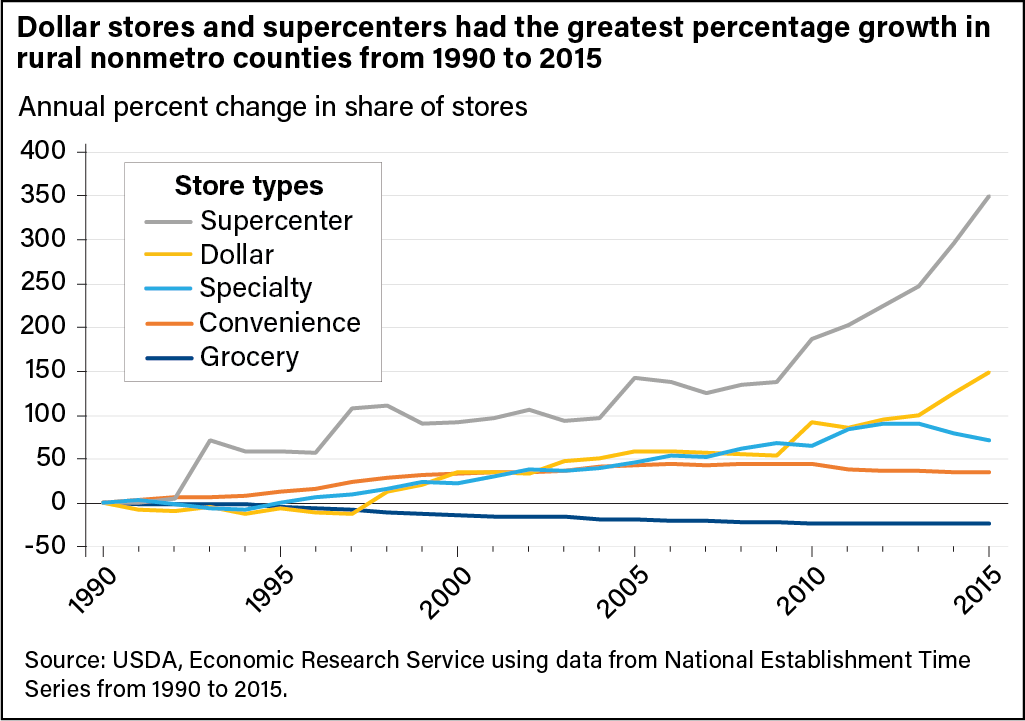
Rural Counties Losing Share of Grocery Stores, Gaining Other Types of Food Retailers
- by Alexander Stevens
- 12/7/2021
Rural U.S. consumers may face challenges finding access to retail food stores, especially if they live in regions with high poverty rates and decreasing population. To address the retail food store access issue, Federal policymakers have passed legislation such as the 2010 Healthy Food Financing Initiative. It was created to attract grocery stores to certain areas and give existing retailers incentives to sell healthy products in underserved communities.
USDA, Economic Research Service (ERS) researchers recently examined the changing retail food landscape in the United States, with a focus on rural areas and grocery stores. They found that in rural counties, grocery stores have declined, while dollar stores and supercenters have increased steadily. They also found that although single-location grocery stores outnumbered chains in 2015, they have been decreasing in share of food retailers.
Using data from the National Establishment Time Series, ERS researchers studied the food retail landscape across the 48 contiguous States from 1990 to 2015. They conducted their analysis using descriptive statistics on three categories of counties based on population size: rural nonmetro (fewer than 2,500 people), small urban nonmetro (2,500 to 19,999 people), and large urban nonmetro (20,000 or more people). The researchers divided retailers into five categories: grocery stores, convenience stores, specialty food stores, warehouse clubs and supercenters, and dollar stores. They studied changes in the number and types of these stores in rural nonmetro counties and compared that data with large and small urban nonmetro counties.
Results showed that of the 1,947 nonmetro counties in the contiguous United States, rural nonmetro counties had fewer of all five types of stores than large and small urban nonmetro counties. In 2015, there were 23 counties without food retailers of any type, and all of those were in rural nonmetro counties. Of the 44 counties with no grocery stores, 40 were rural nonmetro and 4 were urban nonmetro. There were 41 nonmetro counties with just one food retailer, and 115 with only one grocery store.
Single-location grocery stores, as opposed to chain stores, made up a larger percentage of the grocery stores in rural counties than in nonmetro urban counties. In 2015, single-location grocery stores comprised about 82 percent of all food stores in rural counties, compared with about 70 percent in large urban nonmetro counties and 74 percent in small urban nonmetro counties.
ERS researchers identified several trends in the retail food landscape in rural nonmetro counties over the 25-year period. The share of grocery stores decreased, while convenience stores, specialty food stores, warehouse clubs and supercenters, and dollar stores have become more plentiful. Dollar stores and supercenters grew the most in percentage terms—150 percent and 350 percent, respectively—partly because they were almost non-existent in 1990.
This article is drawn from:
- Stevens, A., Cho, C., Cakir, M., Kong, X. & Boland, M.A. (2021). The Food Retail Landscape Across Rural America. U.S. Department of Agriculture, Economic Research Service. EIB-223.
You may also like:
- Food Environment Atlas. (n.d.). U.S. Department of Agriculture, Economic Research Service.
- Food Access Research Atlas. (n.d.). U.S. Department of Agriculture, Economic Research Service.
- Cho, C., McLaughlin, P.W., Zeballos , E., Kent, J. & Dicken, C. (2019). Capturing the Complete Food Environment With Commercial Data: A Comparison of TDLinx, ReCount, and NETS Databases. U.S. Department of Agriculture, Economic Research Service. TB-1953.
- Volpe, R. (2017). Independent Grocery Stores in the Changing Landscape of the U.S. Food Retail Industry. U.S. Department of Agriculture, Economic Research Service. ERR-240.


